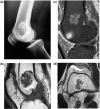The incidental skeletal lesion: ignore or explore?
- PMID: 19965292
- PMCID: PMC2797467
- DOI: 10.1102/1470-7330.2009.9009
The incidental skeletal lesion: ignore or explore?
Abstract
The 'leave me alone' bone lesions are very classical, and, as indicated by their name, do not require any further investigation. There are very typical cases, and there are also more difficult ones, and they can be especially difficult to manage if the patient has a known cancer.
Figures





References
-
- Yanagawa T, Watanabe H, Shinozaki T, Ahmed AR, Shirakura K, Takagishi K. The natural history of disappearing bone tumours and tumour-like conditions. Clin Radiol. 2001;56:877–86. doi:10.1053/crad.2001.0795. PMid:11603890. - DOI - PubMed
-
- Kontogeorgakos VA, Xenakis T, Papachristou D, et al. Cortical desmoid and the four clinical scenarios. Arch Orthop Trauma Surg. 2009;129:779–85. doi:10.1007/s00402-008-0687-6. PMid:18612646. - DOI - PubMed
-
- Masciocchi C, Sparvoli L, Barile A. Diagnostic imaging of malignant cartilage tumors. Eur J Radiol. 1998;27(Suppl 1):S86–90. doi:10.1016/S0720-048X(98)00048-5. PMid:9652507. - DOI - PubMed
-
- Kyriakos M, McDonald DJ, Sundaram M. Fibrous dysplasia with cartilaginous differentiation (“fibrocartilaginous dysplasia”): a review, with an illustrative case followed for 18 years. Skeletal Radiol. 2004;33:51–62. doi:10.1007/s00256-003-0718-x. PMid:14647989. - DOI - PubMed
-
- Skeletal Lesions Interobserver Correlation among Expert Diagnosticians (SLICED) Study Group. Reliability of histopathologic and radiologic grading of cartilaginous neoplasms in long bones. J Bone Joint Surg Am. 2007;89:2113–23. doi:10.2106/JBJS.F.01530. PMid:17908885. - DOI - PubMed
Publication types
MeSH terms
LinkOut - more resources
Full Text Sources
Medical
